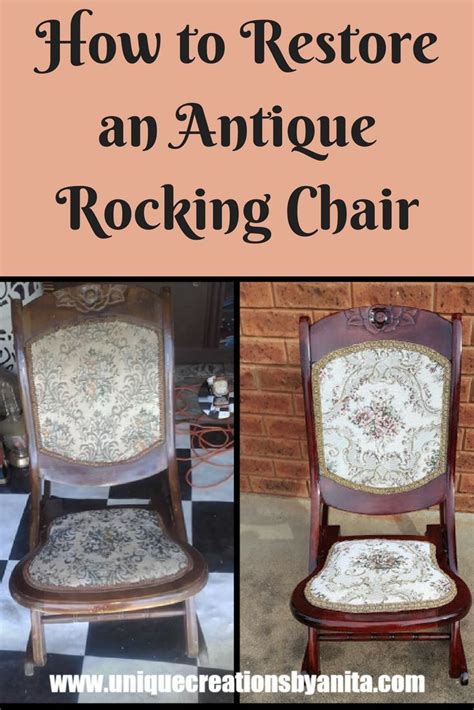Imagine stepping into a room where time seems to have paused, and a magnificent piece of art stands as a testament to enduring craftsmanship. In a world consumed by mass production and disposable furniture, the age-old tradition of chair restoration elevates humble objects into timeless treasures. Acquiring the skills to breathe new life into a worn-out chair is a rewarding endeavor that not only adds aesthetic appeal to your surroundings but also cultivates a sense of connection with the past.
From the delicate intricacies of hand-carved details to the sophisticated harmonies of colors and fabrics, restoring a chair calls upon a blend of practical techniques and creative vision. With determination and patience, one can embark on a journey to explore the boundless possibilities of chair revival. Ancient recipes for wood finishes, long-forgotten upholstery techniques, and a plethora of tools become a playground for those who dare to embark on this labor of love.
Embarking on the path of chair rejuvenation requires not only skill but also an appreciation for the historical significance of each piece. The story embedded within every crack and imperfection unveils glimpses of the chair's previous life and the hands that once cherished it. Through restoration, the chair awakens once again, and its journey continues, bridging the gap between past and present.
Awakening the dormant beauty within a dilapidated chair goes beyond the act of repair; it invites us to contemplate the passage of time and the narrative of human existence. By engaging in the revival of these forgotten treasures, we become guardians of heritage, artisans of preservation, and champions of sustainable living.
Assessing the Damage and Determining the Scope of Work

The initial step in the process of restoring a chair is to thoroughly inspect and evaluate the extent of the damage. By carefully assessing the condition of the chair, you can determine the necessary repairs and the scope of work required to bring it back to its former glory.
Begin by conducting a detailed examination of the chair's various components, such as the legs, backrest, seat, and any additional decorative elements. Look for signs of wear and tear, such as cracks, scratches, loose joints, or missing parts.
Make a comprehensive list of all the issues identified during the inspection and prioritize them based on their severity and impact on the chair's overall functionality and aesthetics. This will help you establish a clear plan of action and allocate the necessary time, effort, and resources for each repair task.
Consider the types of repairs needed, whether it involves simple fixes like regluing loose joints or more complex tasks such as replacing broken parts or refinishing the chair's surface. Take into account the skill level required for each repair, and determine if you have the necessary expertise or if you may need to seek professional assistance.
Additionally, evaluate the availability and cost of materials and tools required for the restoration process. This assessment will guide you in making informed decisions about whether certain repairs are feasible or if alternative approaches should be considered.
By thoroughly assessing the damage and determining the scope of work, you will establish a solid foundation for the chair repair project. This careful evaluation will ensure that you approach each repair task systematically and efficiently, resulting in a successful restoration and the revival of your cherished chair.
Essential Tools and Materials for Restoring and Reviving Your Favorite Chair
In this section, we will explore the indispensable tools and materials required to embark on the journey of bringing back the beauty and functionality of your beloved chair. Whether it is a treasured vintage piece, a family heirloom, or a simple everyday chair that holds sentimental value, having the right tools and materials is crucial for a successful restoration project.
| Tools | Materials |
|---|---|
|
|
These tools will aid you in dismantling the chair, repairing or replacing its components, and putting it back together. The materials, on the other hand, will provide the necessary elements for refurbishing the chair's structure and appearance, ensuring both comfort and aesthetics in the final result.
Remember to choose high-quality materials that match the style and desired outcome of your project. Whether you aim for a sleek modern design or a classic vintage look, having the right tools and materials will make the process more efficient and enjoyable, leading you to a beautifully restored chair that can be cherished for years to come.
Step-by-Step Guide to Restoring a Chair

In this section, we will provide you with a detailed step-by-step guide on how to restore a chair to its former glory. Whether you have a worn-out dining chair or a beloved heirloom piece, this guide will help you bring it back to life. We will walk you through the entire process, from assessing the damage to selecting the right materials and tools, to executing the necessary repairs.
The first step in restoring a chair is to carefully assess the damage. Inspect the chair for any loose joints, broken parts, or worn-out upholstery. Once you have identified the areas that need attention, make a list of the repairs that need to be done in order of priority. This will help you stay organized throughout the restoration process.
Next, gather all the necessary materials and tools. This may include wood glue, clamps, sandpaper, a chisel, a hammer, and upholstery supplies such as fabric, foam, and a staple gun. It is important to select high-quality materials that match the original design of the chair and will withstand regular use.
| Materials | Tools |
|---|---|
| Wood glue | Clamps |
| Sandpaper | Chisel |
| Upholstery fabric | Hammer |
| Foam | Staple gun |
Once you have everything you need, start by repairing any loose joints or broken parts. Use wood glue and clamps to secure loose joints, and replace or repair any broken parts. Take your time during this step to ensure a strong and stable chair structure.
After fixing the structural issues, it's time to focus on the chair's upholstery. Remove the old fabric, starting from the bottom and working your way up. Take note of the fabric's original order and pattern to use as a reference during reupholstering. Cut and attach a new piece of fabric, ensuring a snug and even fit. Use foam to provide cushioning if necessary, and secure the fabric using a staple gun.
Finally, give your restored chair a finishing touch by sanding any rough edges and applying a fresh coat of paint or varnish. This will not only protect the chair but also enhance its overall appearance. Allow the paint or varnish to dry completely before using the chair.
By following this step-by-step guide, you can successfully restore a chair and transform it into a functional and aesthetically pleasing piece of furniture. Take your time, pay attention to detail, and enjoy the process of bringing new life to your chair.
Injecting a Personal Flair: Innovative Concepts for Restoring Chairs
Unleash your creativity and make your restored chair reflect your unique style with these imaginative ideas. Elevate the overall aesthetic appeal by adding distinctive elements that resonate with your personality and preferences.
One way to infuse your personal touch is through the use of unconventional materials. Consider incorporating unexpected fabrics such as vintage scarves, repurposed denim, or even old comic book pages to upholster the seat and backrest. These distinctive choices will bring a sense of individuality to your chair and captivate anyone who sets their eyes upon it.
Another way to personalize your restored chair is by embracing a theme or a specific era. Whether it's a retro 60s vibe or a rustic farmhouse style, choose colors, patterns, and finishes that align with your chosen theme. This cohesive approach will create a visually striking piece of furniture that complements your overall room decor.
Feel free to explore various painting techniques to add an artistic touch to your chair. Experiment with distressed or ombre finishes, stencil intricate patterns, or even hand-paint a unique design or quote that holds special meaning to you. These artistic flourishes will transform your chair into a true work of art that tells a story.
For those with a penchant for nature, incorporating elements of the outdoors into your chair restoration project can bring a breath of fresh air into your living space. Consider embellishing the chair with natural materials like reclaimed wood, woven rattan, or dried flowers and branches. These organic accents will bring warmth and a touch of serenity to your seating area.
Lastly, don't underestimate the power of personalization through customizing the hardware and detailing. Replace standard screws and bolts with decorative options, add embellishments like decorative nails or studs, or even attach unique knobs or handles to the chair for an added dose of charm that reflects your personal taste.
Remember, restoring a chair is not just about functionality, but also an opportunity for self-expression. By incorporating these creative ideas, you can transform a humble chair into a statement piece that shows off your personality and crafting skills.
FAQ
Is it worth repairing an old chair instead of buying a new one?
Repairing an old chair is definitely worth it, especially if the chair has sentimental value or if it is a high-quality piece. Repairing can be cost-effective and it allows you to keep the chair's original charm.
What are some practical tips for repairing a chair?
When repairing a chair, it's important to first assess the damage and gather the necessary tools and materials. Some practical tips include using high-quality glues and screws, reinforcing weak joints, and sanding or painting the chair for a fresh look.
Are there any inspiring ideas for creatively repairing a chair?
Absolutely! With a little imagination, you can turn the chair repair into an opportunity for creativity. For example, you can reupholster the seat with a fun pattern or colorful fabric, paint the chair with a unique design, or even repurpose the chair into something completely different, like a plant stand or a bookshelf.
How can I determine if a chair is worth repairing?
Before deciding to repair a chair, consider its condition, its sentimental value, and the cost of repairs compared to the cost of a new chair. If the chair has good bones and only needs minor repairs, it's likely worth repairing. However, if the damage is extensive or the cost of repairs is high, it may be more practical to invest in a new chair.
What are the benefits of repairing a chair instead of throwing it away?
Repairing a chair instead of throwing it away has several benefits. It reduces waste and contributes to a more sustainable lifestyle. It also allows you to keep a unique piece of furniture with sentimental or historical value. Additionally, repairing a chair can be a rewarding DIY project that helps improve your skills and creativity.



